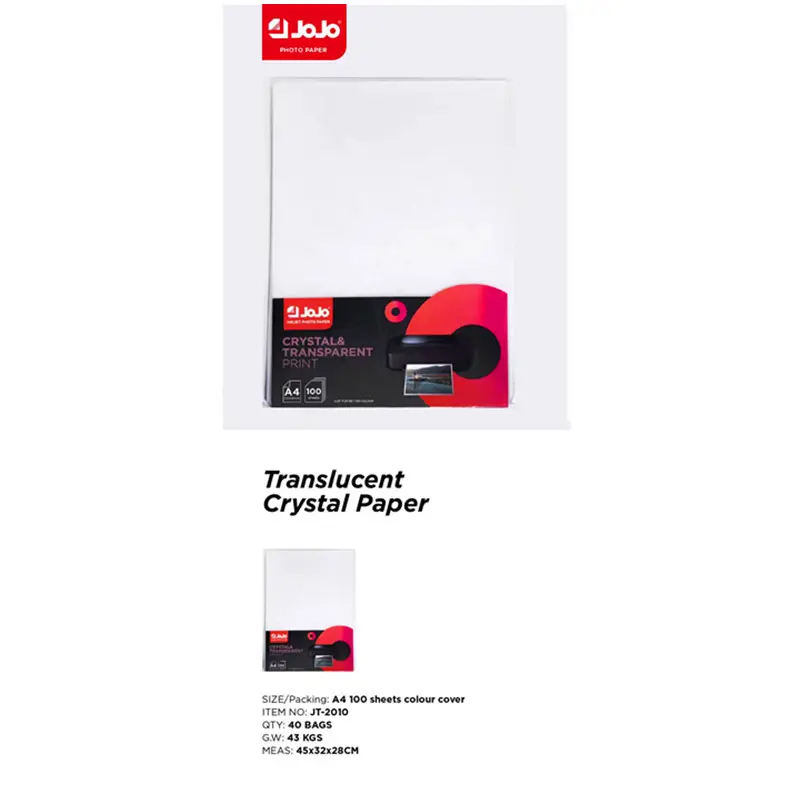If you need any help, please feel free to contact us
Inkjet Ink Viscosity And Printhead Performance
In the world of digital printing, the interaction between ink properties and printhead technology plays a critical role in determining overall print quality and efficiency. Among various ink characteristics, viscosity stands out as a key factor influencing the smooth operation of inkjet printers, especially when printing on different types of media such as thermal paper 80x80, glossy photo paper double sided, and 180gsm photo paper.

Understanding Ink Viscosity
Viscosity refers to the thickness or resistance to flow of a fluid. In the context of inkjet ink, viscosity affects how easily the ink can be ejected through the microscopic nozzles of the printhead. Ink that is too thick may clog nozzles, causing interruptions in printing and reducing image quality. Conversely, ink that is too thin can advance to excessive spreading on the paper surface, resulting in blurry prints and color bleeding.
Ink manufacturers carefully formulate ink viscosity to match specific printer and media requirements. The ideal viscosity range ensures that droplets form properly, are consistent in size, and reach the paper without deformation. This is particularly important for media types like thermal paper 80x80, which is commonly used for receipts and requires fast drying and precise ink adhesion.
Printhead Performance and Ink Interaction
Printheads contain thousands of nozzles that deliver ink droplets with high precision. Their performance depends on both mechanical factors and ink characteristics, including viscosity. When printing on substrates like glossy photo paper double sided, the printhead must maintain stable droplet ejection to achieve sharp images on both sides of the paper without smudging or ink pooling.
Printhead technology must be compatible with various ink viscosities, as different applications require different ink formulations. For example, thermal paper 80x80 typically uses ink designed for fast drying and resistance to heat exposure. The viscosity of this ink is adjusted so that it can be jetted cleanly without affecting the sensitive coating of the thermal paper.
In contrast, printing on thicker media such as 180gsm photo paper involves challenges related to ink absorption and surface texture. The heavier weight and denser fiber structure of 180gsm paper means that ink droplets need to penetrate the surface without spreading excessively. The printhead must eject ink with precise velocity and volume, ensuring consistent coverage and vibrant colors.
Impact on Print Quality and Durability
When ink viscosity and printhead performance are well-matched, the result is high-quality prints with accurate color reproduction, sharp details, and smooth gradients. On glossy photo paper double sided, proper ink viscosity prevents issues like ghosting or bleeding through the paper, which can degrade image clarity on either side.
Similarly, using ink with appropriate viscosity on thermal paper 80x80 helps maintain print durability, especially in environments where the prints are exposed to heat or moisture. Poor viscosity control can advance to smudging or fading, which are undesirable for receipts or tickets that need to remain legible for extended periods.
For 180gsm photo paper, which is often chosen for professional photo prints and marketing materials, ink viscosity influences not only the visual quality but also the tactile feel of the print. Balanced ink flow ensures that the paper does not become overly saturated, preserving the paper’s structural integrity and avoiding curling or wrinkling.
Challenges and Considerations
Formulating inks with the right viscosity for diverse printing needs requires a thorough understanding of both chemistry and print technology. Variables such as ambient temperature, printer speed, and media type all affect ink behavior. Printers operating at high speeds may require inks with slightly lower viscosity to maintain smooth droplet formation and prevent nozzle clogging.
Moreover, media surfaces vary widely in their absorbency and coating. Glossy photo paper double sided demands inks that dry quickly on smooth surfaces while maintaining adhesion on both sides. Thermal paper 80x80, on the other hand, uses heat-sensitive coatings that interact differently with ink compared to traditional photo papers.
The choice of paper weight also plays a role. With 180gsm photo paper, the higher weight means the paper can handle more ink without warping, but the ink must still be formulated to dry rapidly and maintain color fidelity.
Practical Tips for Printers and Users
For users aiming to optimize print quality and equipment longevity, attention to ink viscosity and media compatibility is crucial. Regular maintenance of printheads can help prevent clogging caused by inappropriate ink flow. It is also advisable to match ink types to the intended paper — using ink designed for photo paper on thermal paper 80x80 may advance to poor results and possible damage.
Testing different combinations of inks and media like glossy photo paper double sided and 180gsm photo paper allows printers to find a balance that suits their particular needs, whether for photography, commercial printing, or point-of-sale applications.
Inkjet ink viscosity is a fundamental aspect affecting printhead performance and the quality of printed output. Whether printing on thermal paper 80x80, glossy photo paper double sided, or 180gsm photo paper, the compatibility between ink viscosity and printhead technology determines the sharpness, durability, and visual appeal of prints. Careful selection and testing of inks and media can advance to smoother printing processes and more reliable results across various digital printing applications.

 English
English Español
Español 中文简体
中文简体 Português
Português

